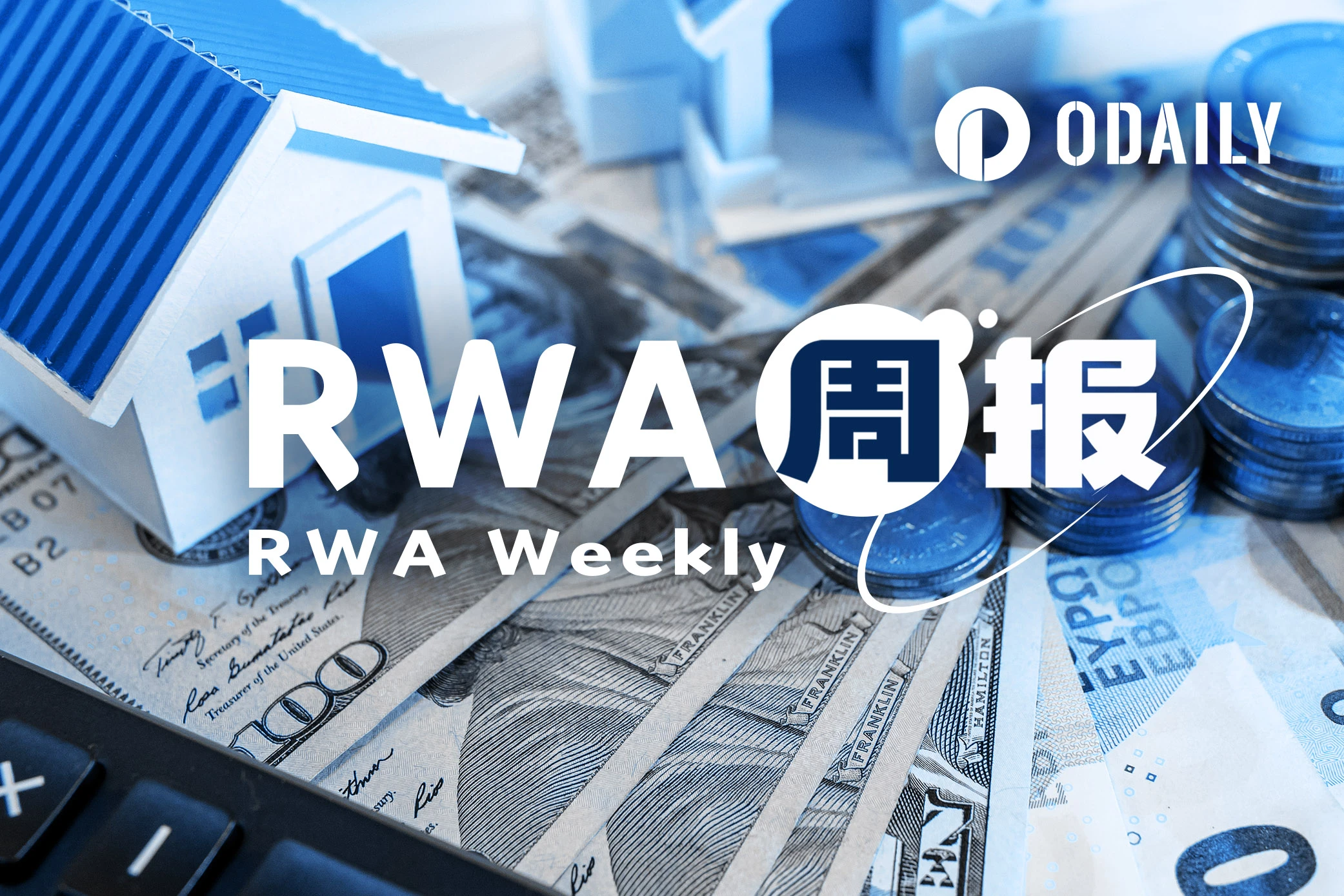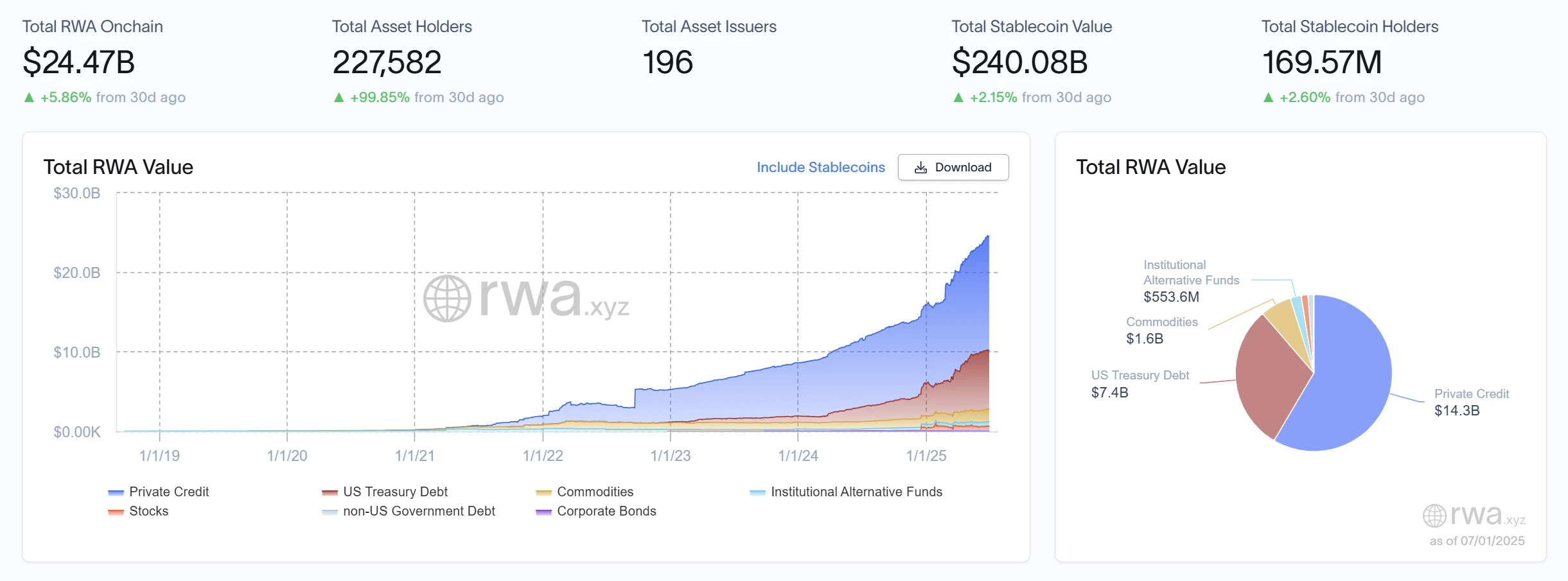Original | Odaily Planet Daily (@OdailyChina)
Author | Ethan (@ethanzhang_web3)

RWA Market Performance
According to the latest data from RWA.xyz, as of July 1, 2025, the total on-chain value of RWA reached $24.47 billion, an increase of 0.74% from $24.29 billion on June 24, continuing a mild upward trend. The number of on-chain asset holders grew from 209,678 to 227,582, with a net increase of nearly 18,000 people in a single week, an increase of 8.55%, marking three consecutive weeks of user growth exceeding 5%, indicating a sustained rise in market participation enthusiasm. The number of asset issuances increased from 194 to 196. The total value of stablecoins rose from $238.99 billion to $240.08 billion, an increase of 0.46%; the number of stablecoin holders also grew from 168.65 million to 169.57 million, an increase of 0.55%.
In terms of asset structure, private credit continues to maintain a core position within RWA assets, growing from $14.2 billion to $14.3 billion this week. U.S. Treasury bonds remained stable, with a total value still at $7.4 billion, demonstrating its solid foundational status as a "defensive asset," with ongoing demand for stable asset allocation in the market. Commodity assets stabilized at $1.6 billion, showing no significant change; institutional alternative funds increased from $543 million to $553.6 million, although the growth was limited, indicating that diversified assets continue to be favored.
Trends (Compared to Last Week)
The total on-chain market value continues to rise slightly, with user growth accelerating significantly: total assets increased slightly from last week, but more notably, the total number of asset holders is approaching 230,000, indicating that RWA is attracting a broader market user participation, with ecological diffusion effects gradually emerging; private credit and U.S. Treasury bonds continue to form the main axis, maintaining a "high yield + stable defense" structure: private credit, as a high-yield asset, continues to expand, with market risk appetite remaining stable; at the same time, the total value of U.S. Treasury bonds remains high, showing that defensive allocation is still popular in the current macro environment; diversified asset portfolios are steadily rising, with a more balanced structure: commodities and alternative funds maintain a growth trend, indicating that investors' recognition of diversified asset portfolios and risk hedging strategies is continuously increasing; the asset issuance side has slightly expanded, possibly warming up for future category expansion: the number of asset issuers increased from 194 to 196, with new agreements and assets set to launch, expected to bring new incremental space to the on-chain asset structure.
Overall, this week the RWA market maintains a "steady expansion" operational rhythm: market value grows slowly, user scale expands rapidly, and asset category structure progresses steadily. High-yield and low-volatility assets synergistically form the basis for allocation, while diversified assets such as commodities and alternative funds serve as flexible supplements. It is also recommended to pay attention to the platform's dynamic disclosures and structural expansions in emerging sectors such as equity assets, preparing for medium- to long-term layouts.

Key Events Review
U.S. Senate Procedural Vote Passes Trump Tax Reform Bill
On Saturday local time, the U.S. Senate passed the Trump tax reform bill in a key procedural vote by a narrow margin of 51 votes to 49, increasing the likelihood of the bill's passage in the coming days. The "Big and Beautiful" tax and spending bill is a core agenda of Trump's second term, and after several hours of delay, all Republican senators except for two voted in favor. Due to some senators insisting on negotiating with Republican leadership, the originally scheduled 15-minute vote was open for more than three hours. This bill, advanced using the special "budget reconciliation" procedure, allows Republicans to pass legislation with a simple majority, but must ensure that the provisions comply with Senate rules.
According to the Korean Economic Review, eight major banks in South Korea are preparing to establish a joint venture to issue a won stablecoin. Participating institutions include KB Kookmin Bank, Shinhan Bank, Woori Bank, Nonghyup Bank, Korea Development Bank, Korea Securities Finance Corporation, Citibank Korea, and Standard Chartered Bank Korea. The project is being jointly promoted by the banks, the Open Blockchain and Decentralized Identifier Association, and the Korea Financial Telecommunications and Clearing Institute, and discussions are still ongoing regarding the underlying infrastructure.
If regulatory approval is obtained, the joint venture is expected to officially launch by the end of this year or early next year. The project team is currently considering two issuance models: one is a trust model, where customer funds are independently trusted before issuing stablecoins; the other is a deposit token model, linking stablecoins directly to bank deposits.
U.S. SEC and NYSE Discuss Crypto Rule Reform, Promoting Tokenized Assets into the Mainstream Market
Reports indicate that the U.S. SEC's special working group on crypto assets held a closed-door meeting with the New York Stock Exchange on June 24 to discuss how tokenized assets can gain compliance acceptance within the existing financial framework. The two parties focused on the issue of regulatory fragmentation between traditional and crypto markets and exchanged views on universal listing standards for traditional securities issued on blockchain and spot crypto ETFs. This meeting is seen as an important signal to accelerate the entry of tokenized assets into exchanges, reflecting the willingness of regulatory agencies and mainstream markets to jointly promote compliance innovation.
Nasdaq Calypso Platform Integrates Canton Network, Supporting Blockchain-based Collateral Management
Nasdaq announced that its capital markets platform Calypso has integrated the blockchain project Canton Network, enabling automated collateral and margin management around the clock. This integration is driven by QCP, Primrose Capital Management, and Digital Asset, supporting real-time capital flow and collateral allocation across multiple asset classes, including crypto derivatives, fixed income, and over-the-counter derivatives. The Canton technology under Digital Asset has been used by institutions such as Broadridge and Equilend to build collateral management solutions, becoming an important infrastructure in this field.
Chainlink Partners with Mastercard to Support 3 Billion Users in Purchasing Cryptocurrency On-chain
Chainlink has partnered with Mastercard to allow over 3 billion Mastercard holders to purchase cryptocurrency directly through on-chain services. This integration is supported by Chainlink's cross-chain protocol, in collaboration with zerohash, Swapper Finance, Shift4 Payments, XSwap, and Uniswap, bridging the traditional payment world with DeFi.
This service relies on Chainlink's secure interoperability infrastructure and Mastercard's global payment network, allowing users to pay with fiat currency via their bank cards, ultimately completing cryptocurrency exchanges on-chain. Zerohash provides compliant liquidity and custody support, Shift4 handles card payments, XSwap searches for and connects to Uniswap and other DEX liquidity, while Swapper Finance integrates resources to create a unified and convenient user experience.
Chainlink co-founder Sergey Nazarov stated that this partnership marks an important step in the integration of traditional finance and DeFi. Mastercard also stated that it will continue to explore secure and compliant on-chain payment methods to promote broader applications of cryptocurrency globally. The Chainlink-powered platform Swapper Finance has launched today.
Grove announced the official launch of its institutional-grade DeFi credit infrastructure protocol, securing an initial funding allocation of $1 billion from the Sky ecosystem (formerly MakerDAO) to support the Anemoy AAA CLO on-chain strategy (JAAA) launched in collaboration with Janus Henderson and Centrifuge. This marks the official implementation of the first fully on-chain AAA-rated CLO strategy. Grove's non-custodial protocol aims to serve as a capital channel between TradFi and DeFi, providing accessible and compliant high-quality credit assets for the protocol. The protocol is incubated by Grove Labs, a subsidiary of Steakhouse Financial, and aims to promote the diversification of RWA and the development of the on-chain credit market.
Midas Joins Fasanara, Morpho, and Steakhouse to Launch On-chain Private Credit Product mF-ONE
The on-chain asset tokenization platform Midas has announced the launch of a new private credit product, mF-ONE, which tracks Fasanara's F-ONE fund, covering fintech receivables, SME loans, real estate mortgage credit, and neutral strategies. Qualified investors can use mF-ONE as collateral in the Morpho market to borrow stablecoin liquidity provided by the USDC treasury curated by Steakhouse, enhancing capital efficiency. The project is supported by institutions such as Stake Capital and GSR, marking further advancement in the tokenization of DeFi credit.
Hot Project Updates
Plume Network

One-sentence introduction:
Plume Network is a modular Layer 1 blockchain platform focused on the tokenization of real-world assets (RWA). It aims to transform traditional assets (such as real estate, artworks, equity, etc.) into digital assets through blockchain technology, lowering investment barriers and increasing asset liquidity. Plume provides a customizable framework that supports developers in building decentralized applications (dApps) related to RWA and integrates DeFi with traditional finance through its ecosystem. Plume Network emphasizes compliance and security, committed to providing solutions that bridge traditional finance and the crypto economy for institutional and retail investors.
Recent updates:
On June 24, Plume Network released a new white paper outlining how it complies with the EU's regulatory framework for crypto assets (MiCA). The white paper was reviewed by the Dutch Authority for the Financial Markets (AFM) on June 19 and registered with the European Securities and Markets Authority (ESMA), in accordance with EU Regulation 2023/1114.
On June 30, Plume announced that over 100,000 users now hold RWA assets on its platform, with a total value exceeding $100 million. The types of assets have expanded from government bonds to private credit and institutional funds, reflecting the diversity and growth of the Plume ecosystem.
TunaRWA (TUNA)

One-sentence introduction:
TunaRWA is a Web3 project focused on the tokenization of rights to scarce natural resources, dedicated to bringing real-world assets such as global fishing rights on-chain. The project is based on high-value fishery resources like the Southern Bluefin Tuna in Australia, providing users with stable income opportunities backed by physical assets through rights confirmation, leasing, and smart contract dividend mechanisms. TunaRWA combines the traceability and transparency of blockchain to achieve the digitization, fragmentation, and global participation in resource investment. Its native token TUNA is used for rights proof, rental dividend distribution, and community governance. TunaRWA aims to promote the "democratization" of investment in scarce natural resources and build a new infrastructure connecting the real economy with decentralized finance.
Previous updates:
On April 28, TUNA was recognized by the Korea University-Zhejiang University Shanghai Advanced Research Institute's Digital New Finance Joint Laboratory, which will establish a special research topic. This joint laboratory was co-founded by Zhejiang University Shanghai Advanced Research Institute and Hana Financial Group, focusing on cutting-edge technology research in blockchain, metaverse, big data, and asset encryption.
On May 9, it was reported that core members of TUNA appeared at BlackRock's San Francisco headquarters. Previously, the global asset management giant BlackRock announced that it had completed the on-chain mapping of $150 billion in assets, covering diverse fields such as real estate trusts and commodities. This case is seen as a milestone in the commercialization of RWA, validating the feasibility of technology implementation. The market speculated that both parties might announce specific cooperation plans in May, which led to a temporary 32% surge in the TUNA token.
Related Links
Summarizing the latest insights and market data in the RWA sector.
《BlackRock and JPMorgan Compete for Layout, 2025 RWA Full Track Guide》
This article will analyze the current most promising RWA sub-sectors and highlight the most representative leading projects in various fields.
This article organizes the content of a speech titled "Real World Asset Practices in an Uncertain World" given by Cobo's Lily Z. King at an RWA event at JunHe Law Offices in Hong Kong on June 10, 2025, for several brokerage fund stablecoin institutions and family offices.
免责声明:本文章仅代表作者个人观点,不代表本平台的立场和观点。本文章仅供信息分享,不构成对任何人的任何投资建议。用户与作者之间的任何争议,与本平台无关。如网页中刊载的文章或图片涉及侵权,请提供相关的权利证明和身份证明发送邮件到support@aicoin.com,本平台相关工作人员将会进行核查。



